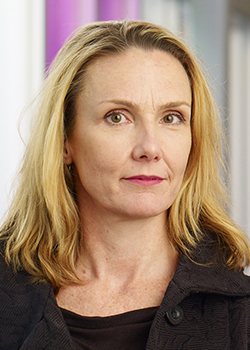Dr. Megan Levings and her team have recently published two papers on the very different functions and uses of regulatory T cells (Tregs). Tregs are immune cells that help to rein in immune responses to ensure that they don’t go too far and begin harming healthy tissues in their pursuit of foreign invaders.
BCCHR's Ask an Expert Series

Obsessive-compulsive disorder (OCD) affects between one and three per cent of kids, is under-diagnosed and undertreated. Left untreated, OCD often persists into adulthood and limit one's ability to function at work, school and home.
We asked an expert about a book she co-authored to help community-based clinicians deliver evidence-based treatment to OCD-affected children and their families.
Dr. S. Evelyn Stewart is the medical director of the Provincial OCD Program, an investigator at BC Children’s Hospital and professor at the University of British Columbia. She co-authored OCD in Children and Adolescents: The ‘OCD is not the boss of me’ manual, which was published earlier in 2020, with Dr. Katherine McKenney, a psychologist with the Provincial OCD Program, and psychologist Dr. Annie Simpson.
We caught up with Dr. Stewart to learn more about OCD and evidence-based treatment for this challenging mental illness.
Q: What is OCD?
OCD is a disease characterized by obsessions and/or compulsions that cause significant distress, take up a great deal of time or limit a person’s functioning. An obsession is a repetitive, intrusive thought or image, and a compulsion is a recurrent action or mental act that is intended to reduce distress related to the obsession.
For example, checking your stove is turned off does not mean you have OCD, but it could be OCD if you check it so much that you’re late for school or can’t go to sleep at night.
Many famous individuals have overcome OCD to excel in sports, business and the arts. Unfortunately, OCD is often hidden.
Q: At what age does OCD typically start?
OCD usually begins during childhood and adolescence, between around seven and 18 years old. Its onset occurs slightly earlier in boys than in girls.
Q: What should parents be aware of?
If a child has become quieter, more secretive, engaging in superstitious behaviours and/or if the child has become insistent about specific patterns, this may be OCD. For example, OCD compulsions may include restarting a bedtime ritual again and again until it has been done exactly right, or repeatedly asking a parent for reassurance (about their health, actions, safety or other topics).
Kids may not share their OCD worries because they’re embarrassed or ashamed. They may be experiencing intrusive thoughts, for example, that they may physically hurt someone else or themselves, or that they may perform a sexually deviant act even though they don’t want to. An individual without OCD wouldn’t be thrown off by an odd, random thought. Those with OCD tend to take their thoughts very literally. As care providers, one of the first things we try to teach kids with OCD is that, “a thought is just a thought.”
We receive questions from parents of toddlers that don’t want their peas touching their corn or get very upset if their toys aren’t lined up in a particular way. That is not OCD. It’s a normal developmental phase where the child is learning to exert more control over their environment. We would expect them to outgrow this rigidity around age five.
Q: What’s the typical cause of OCD?
OCD is caused by a combination of genetic and environmental factors. OCD runs in families and is a complex genetic disorder, meaning that hundreds or thousands of inherited DNA molecules drive an individual’s risk level. Stressful or medical events and other environmental influences may also play an important role in contributing to OCD onset. While a life event such as parents getting a divorce or change of schools is unlikely to cause OCD in itself, onset may occur when combined with high genetic risk.
Q: What’s the best treatment for OCD?
We are lucky to have scientifically proven treatments for OCD, including medication and non-medication options. Unfortunately, stigma persists around mental illnesses, including OCD. Children and teens may not seek help, believing they should be able to “get over it” themselves. But OCD is a real disease, with proven brain functioning differences that interfere with normal life and improves with treatment.
“OCD can totally devastate and turn a child’s life upside down, and yet it can be brought into control with treatment in a pretty short timeframe. That’s one of the reasons we wrote the book.”
The two main treatments proven for child-onset OCD include cognitive-behavioral therapy (CBT), specifically a type called exposure and response prevention (ERP), and a family of medications called serotonin-reuptake inhibitors.
While ERP leads to dramatic improvements and even remission of OCD, community providers are often untrained in how to provide it. As such, they may rely on unproven methods such as relaxation training, which are proven to be no more effective than placebo or sugar pills.
“Deep breathing does not cure OCD any more than it would cure diabetes or cancer.”
Our OCD program, which was founded at BC Children’s Hospital in 2011, sees psychologists, social workers and psychiatrists work together to provide family-based ERP groups. We run parent groups concurrently with child and teen groups. We know that OCD tends to impact everyone at home and that a parent’s response to the obsessions and compulsions can really impact the course of OCD. The manual is based on our treatment program, which has been supported by positive results from our related clinical research.
Q: What is Exposure and Response Prevention (ERP) Therapy?
ERP involves exposing yourself to a specific situation that triggers your OCD, and then refusing to do the rituals that are usually used at these times. With practice, the OCD-affected individual (and their brain) learns they don’t need to do the ritual to make the obsession disappear.
For example, rather than coaching kids who are afraid of germs to avoid them, we do the opposite. The child takes the lead in planning exposures, done in a graded way to trigger their OCD. Then, instead of reacting in their typical way to make them feel better – perhaps saying a prayer or washing their hands in a specific way after touching dirt – we encourage them to sit with that distress until it gradually decreases.
ERP helps to disconnect the obsessive thought from the following ritual or compulsion that becomes almost a reflex over time. It’s those compulsions that steal hours, enjoyment and productivity from OCD-affected youths’ lives.
“Sadly, families often give up more and more to the OCD over time. They switch around daily life in an effort to appease or not trigger the OCD. But the more they try, the more OCD takes over. OCD is a bully that is never satisfied.”
Q: How will your manual help kids with OCD?
Our book is written for mental health workers who want to provide evidence-based treatment for OCD in children and adolescents. It includes handouts that are specific to children, teens and parents. Based upon decades of combined experience, it offers pearls of wisdom, tips and tricks for what to do when things go wrong and answers for commonly asked questions by parents, kids and teens.
This manual focuses mainly on exposure response prevention approaches, but it also addresses factors such as mental illness stigma, quality of life, self-esteem and medications. We discuss how OCD impacts families and the challenges that parents face in limiting OCD behaviours when they see their child suffering.
Over the years, we have been asked to share our treatment modules by local, national and international colleagues. This book was inspired by our desire to enable access to scientifically proven ERP treatment for kids with OCD, no matter where they live.
Q: If parents suspect that their child has OCD, what should they do?
Some great online resources include websites of the International OCD Foundation, Anxiety Canada and Child Mind Institute. If caregivers are concerned their child has OCD, they should discuss this with their family doctor, pediatrician, therapist or counsellor.
Related story: Impacts of pediatric OCD are more than just daily headaches for kids and families




